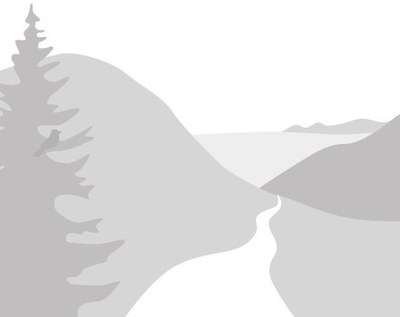Sutton Mountain
Enjoy the unfolding scenery, spring wildflowers including hedgehog cactus, wildlife, geology and solitude while hiking trails and routes in the Sutton Mountain Wilderness Study Area. Sutton Mountain is composed of volcanic ash and pyroclastic flows of the John Day Formation that flowed from the Monument, Oregon area about 16 million years ago. The John Day Formation is the same formation which preserved fossils in the nearby Painted Hills unit of the John Fossil Beds National Monument. The hike to the top of Sutton Mountain is 7.6 miles round trip with 1,650 feet of elevation gain, and the Black Canyon hike is 5.0 miles round trip with 1,363 feet of elevation gain.
Getting There
Sutton Mountain Summit Trailhead
From Prineville, Oregon drive OR-26 east 48 miles to Mitchell. Drive north on OR-207 for ~9.2 miles. One hundred feet beyond Milepost 15, turn left into a small dirt driveway that is easy to miss. Open the wire gate marked by a small BLM sign, enter, and close the gate. Park in a livestock-trampled meadow on far side of creek. Camping is permitted here, but there are no facilities.
Black Canyon Trailhead from Mitchell
At Milepost 66 on OR-26 in Mitchell, turn north on OR-207, drive 9.7 miles to Girds Creek Road (aka South Twickenham Road), and turn left. Drive to Milepost 15 and then ~6 miles further toward Twickenham. The trailhead for Black Canyon on the left (west) side of the road. Park in small parking area on the west side of the road or nearby off the road.
Black Canyon Trailhead from Fossil
Drive OR-19 (John Day Highway) southeast 10 miles from Fossil to a county road signed Twickenham. Turn right and drive south 15.3 miles to the John Day River bridge at Twickenham, a small ranching settlement with no services. Turn left (south) and drive 2.8 miles from the bridge to the mouth of Black Canyon on the right (west) side of the road. Park in small parking area on the west side of the road or nearby off the road.
On the Trail
Sutton Mountain
7.6 miles round trip with 1,650 feet of elevation gain
From the parking area, walk to the right along a fence on a grassy cattle path for 400 feet, then around a locked metal gate marked "Area Closed to Motorized Use." The old roadbed/cattle path crosses a dry grassland with juniper trees. Just before a barn, turn left to follow the grassy old roadbed up the dry wash. One mile from the parking area, the roadbed curves right across the dry wash on old roadbed. Hike 0.7 mile to viewpoints where sparse juniper forest changes to slopes of sage and wildflowers. The trail then levels out to fields of colorful wildflowers—red and yellow paintbrush, yellow stonecrop, blue flax, and blue lupine. At 2.1 miles from the parking area, reach an open wire gate beside an old corral where the roadbed ends, then proceed straight 60 feet and turn uphill to left of far side of an old wire fence. Follow fence line straight uphill through a bunchgrass meadow. In 0.6 mile, the fence line ends on a broad prairie. Continue from here straight toward the summit, the high point ahead. Where the old roadbed becomes visible again, follow it, angling right to a pass (4,550 ft) with views west to Cascade peaks. Look for the pink hedgehog cactus blooms below the summit on the east ridge. The views improve with a bushwhack to left along a rimrock cliff edge ~0.3 mile from the summit. Lichen encrust the rimrock, and a single juniper tree provides shade at the summit.
Black Canyon
5.0 miles round trip with 1,363 feet of elevation gain
Hike the gentle grade along the relatively flat bottom of the canyon traveling over a faint path that slowly steepens. Look for waterfalls, side creeks, small offshoots from the main canyon, and multiple access points to steep grassy hills that lead right to the summit. It’s 3.1 miles round-trip to reach the canyon rim, but plan on hiking roughly 5 miles to take in side trips.
Exploring Nature
The best time for spring wildflowers is April and May. Look for lupine, bitterroot, buckwheat, fiddleneck, milkvetch, paintbrush, deep pink hedgehog cactus (near summit), and more. Expect to see abundant wildlife on Sutton Mountain, especially in Black Canyon area. Wildlife sightings include raptors and other birds, pronghorn antelope, mule deer, red fox, coyote, badger, bobcat, mountain lion, longtail weasel, pygmy rabbit, several lizard and snake species, frogs, bats (11 species), and many species of bats and rodents.
Guides & Other Info
- Oregon Desert Guide: 70 Hikes by Andy Kerr, 1st ed (Mountaineers Books 2000).
- 100 Hikes / Travel Guide: Eastern Oregon by William Sullivan, 3rd ed. (Navilus Press 2015).
- Black Canyon Research Natural Area: Guidebook Supplement 52 by Reid Schuller and Sarah Canham (USDA 2019). Contains in depth info on Black Canyon including plant, bird, mammal, reptile and amphibian lists.
- Sutton Montain and Pats Cabin Wilderness Study Area Travel Map
- Sutton Mountain (Oregon Natural Desert Association)
- Black Canyon (Oregon Natural Desert Association)
- Trail Report and Photos of Sutton Mountain on oregonhikers.org
- Suitable Activities: Day Hiking
- Seasons: March, April, May, June, July, August, September, October, November
- Weather: View weather forecast
- Difficulty: Moderate
- Length: 7.5 mi
- Elevation Gain: 1,650 ft
- 4,694 ft
-
Land Manager:
Oregon-Washington BLM
Sutton Mountain Wilderness Study Area
- Parking Permit Required: BLM Permits & Passes
- Recommended Party Size: 6
- Maximum Party Size: 12
- Maximum Route/Place Capacity: 12
- Lower Deschutes & John Day Rivers Pacific Northwest Recreation Map
- USGS Sutton Mountain
- USGS Toney Butte
There are no resources for this route/place. Log in and send us updates, images, or resources.
